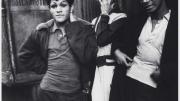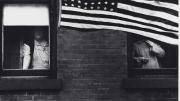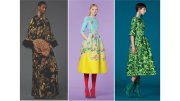Given the current national crises, The Americans, the 1958 book by Robert Frank, is an especially timely document. The Swiss photographer captured a culture in transition: activists and opponents squaring off within a changing racial landscape, people more openly expressing themselves while challenging social norms. New York and Parade, Hoboken, New Jersey are among those on display in “Robert Frank: The Americans” at Andover’s Addison Gallery of American Art through April 11. In one sense, it took an outsider, the exhibit notes, to probe “the defining and enduring dualities of American life and culture—hope and despair, affluence and want, freedom and limitation, community and isolation.”
Robert Frank at the Addison Gallery, Andover, Massachusetts
Robert Frank at the Addison Gallery, Andover, Massachusetts
“Robert Frank: The Americans,” at the Addison Gallery of American Art

New York, by Robert Frank, negative 1955-56
Courtesy of the Addison Gallery of American Art

Parade, Hoboken, New Jersey, Robert Frank, negative 1955-56
Courtesy of the Addison Gallery of American Art
You might also like
England’s First Sports Megastar
A collection of illustrations capture a boxer’s triumphant moment.
Rachel Ruysch’s Lush (Still) Life
Now on display at the Museum of Fine Arts, a Dutch painter’s art proved a treasure trove for scientists.
The Peabody Essex Museum Spotlights Designer Andrew Gn
A landmark exhibition on global fashion
Most popular
Explore More From Current Issue

Mount Vernon, Historic Preservation, and American Politics
Anne Neal Petri promotes George Washington and historic literacy.

On Weekends, These Harvard Math Professors Teach the Smaller Set
At Cambridge Math Circle, faculty and alumni share puzzles, riddles, and joy.






